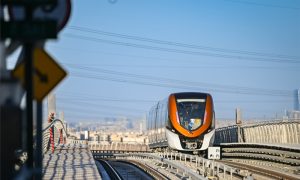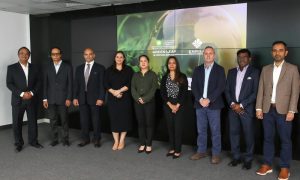WiC: How smart transportation can help region’s city’s achieve their green ambitions
Laurence Batlle, chairwoman of the executive board of RATP Dev, talks about the role of smart urban mobility

To support the drive towards gender balance in the industry, Middle East Consultant and meconstructionnews.com are highlighting female consruction professionals in a series of profiles. By telling their stories and sharing their experiences on our print and digital platforms, we hope to inspire more women to join this vibrant industry. Here Laurence Batlle, chairwoman of the executive board of RATP Dev, talks about the role smart urban mobility can play in helping cities achieve their sustainable and smart ambitions.
Established in 2002, RATP Dev is a subsidiary of the RATP Group. The firm’s mission is to develop, operate and maintain new transportation systems around the world, by drawing on the experience and know-how of the RATP Group. RATP Dev now operates across the Middle East, working on large-scale public transport systems and operations. Its experience spans metro, bus, tramway systems and other ancillary services, and it is keen to work on regional transportation projects through its regional headquarters in the UAE. The firm participated at Middle East Rail 2018, following which we caught up with Laurence Batlle, chairwoman of the executive board of RATP Dev, to talk about how smart urban mobility solutions can help cities achieve their sustainable and smart ambitions.
How are smart cities such as Dubai adopting new urban mobility solutions?
Dubai has already emerged as a global hub sitting at the intersection of urban development, technology, data and mobility. Its success is very apparent in many fields, and perhaps especially with the award of World Expo 2020, where mobility is an essential element. Dubai is already innovating, rapidly supported by strategies for AI, IOT, data wealth, blockchain – and innovation itself.
The smart city combines the physical network – the integrated multimodal mobility solutions – and the digital network – the high-speed broadband network, which is the backbone of the digital experience. Together, they connect government, people, business and of course data. Access to mobility and a passenger-centric approach – easy, accessible, safe, secure, comfortable, sustainable and affordable – is a major factor in determining the quality of urban life.
The smart city of Dubai is a great example of the adoption of world-class public transport development with a visionary approach. The share of public transport in Dubai has risen from 6% in 2006 to 17% in 2017, and the Roads & Transport Authority (RTA) has set a target of 25% of all journeys to be driverless by 2030, in order to reduce congestion and carbon emissions.
What challenges do smart cities face in rolling out smart mobility solutions?
The challenges and opportunities of the sustainable smart city are driving the transformation of the mobility industry and increasing the recognition that the future of urban public mobility innovation must be people-centric, technology-enabled, sustainable and inclusive.
In a visionary region that is pioneering ambitious smart cities on an unprecedented scale, the vision of the city planners must be matched by urban mobility companies, which are today facing a double challenge. The first challenge is to maintain existing legacy urban transport infrastructure, to optimise working lives. The second is to make exciting new urban mobility possibilities a reality in the smart city.
How can smart cities fully embrace and roll out mobility innovations on a wide scale?
Automated transport systems represent the future of transport across the globe. We see the impact of automation with new driverless metro infrastructure. By 2020, 75% of new metro systems will be driverless. The RATP Group is a pioneer and a leader in automated metro lines. It all began in Paris when Line 14, the world’s first high-capacity automated line, entered service in 1998. Passengers quickly appreciated the innovation, and the figures speak for themselves – the number of passengers taking Line 14 has risen in fifteen years from 100,000 to 700,000 passengers a day.
Greater punctuality and reliability, and the ability to adapt transport supply to demand instantaneously, are all reasons explaining the line’s success. The system’s multiple benefits prompted thinking to automate Line 1, the oldest and most heavily used in Paris. The project to automate Line 1, without any traffic interruption, was completed at the end of 2012. As of today, we are still the only operator in the world that has automated an existing high-capacity metro line.
What innovations in mobility have the potential to have a dramatic impact on the smart city transportation landscape?
We are seeing innovation in four principal areas:
Innovating in mobility technology and the impact of automation. Automated transport systems represent the future of transport across the globe, and one exciting area is the fully autonomous vehicle.
Innovating the passenger experience. Passengers’ needs and expectations are changing fast, and the key is to understand and respond with new on-demand services.
Innovating the start-up ecosystem. No one has a monopoly on innovation today, and we need to partner with the start-up ecosystem. The Dubai smart city accelerator is a great example of this.
Innovating around data. Smarter cities are an opportunity to shape and build these new urban environments on the platforms of high-speed connectivity, driving big data analytics to model operational information and passenger movements to achieve optimum efficiency in tram services, for example.
Cities are changing, mobility is changing and passenger expectations are changing. This demands constant innovation. The digital transformation and disruption of public transport is putting the passenger at the heart of the mobility experience, with new innovation opportunities for all who are able to embrace them.
Mobility as a Service (MaaS) is the integration of various forms of transport services into a single mobility service, accessible on demand. To meet a customer’s request, a MaaS operator facilitates a diverse menu of transport options: public transport, ride-, car- or bike-sharing, taxi or car rental/lease, or a combination. For the user, MaaS can offer added value through use of a single point of entry to provide access to mobility, with a single payment channel instead of multiple ticketing and payment operations.
Measuring the performance of transportation projects is key to ensuring their immediate and future success. What should authorities look to measure?
The drive for mobility innovation is aimed at building the sustainable smart cities and communities of the future. This means that the work of mobility companies should not just be measured only in terms of kilometres or passenger numbers and travel times, but on the much broader impact they make on a community in three important areas – skills transfer and employment opportunities, social inclusion for staff and passengers, and social responsibility.
What transport projects is RATP Dev working on in the GCC/MENA region?
RATP Dev is active across the GCC and North Africa. We recently signed an agreement with Casa Transports (Casablanca Transportation Authority) to operate, maintain and develop the Casablanca tramway for a 12-year period, starting in December 2017. RATP Dev subsidiary CASA TRAM opened Casablanca’s T1 tram in 2012 and has been the operator since opening, celebrating 100m passengers in 2016. The new agreement covers the commissioning, operation and maintenance of four new tram lines and two BRT (rapid bus transport) routes, making it the most ambitious urban transportation project in Africa. The new agreement includes several initiatives to enhance services, including a focus on innovation and training.
RATP Dev is proud to have earned the trust of Casa Transports, demonstrated by this new agreement for the operation of the Casablanca Tramway and the development of Africa’s largest multimodal urban mobility project. We are committed to meeting the needs of passengers in Casablanca and to supporting the shared goal of Casa Transports and the Kingdom of Morocco in developing world-class transportation systems to help boost the city’s appeal and international reputation.
RATP Dev and SAPTCO, through our joint venture, were awarded the contract by the ArRiyadh Development Authority (ADA) to mobilise, operate and maintain the future bus network in Riyadh, Saudi Arabia. The network will be operated initially using a fleet of around 1,000 vehicles and will include three BRT lines, 21 commuter lines and more than 60 feeder lines (permanent and transport on demand). These lines will be introduced into service in three phases and will ultimately ensure 90 million kilometres annually, targeting to transport more than 100 million passengers every year.













